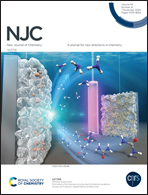Role of dissolved oxygen in nitroarene reduction by a heterogeneous silver textile catalyst in water†
Abstract
The availability of end-user products, including lifesaving medicines and protection materials, from the pharmaceutical, agrochemical, dye, polymer and corrosion industries mainly relies on sustainable catalytic efficiency towards the reduction of nitroaromatics. The recovery of catalysts from the reaction mixture requires additional instrumentation; therefore, dip-catalyst platforms have been developed in the modern research era. Nitroarene reduction is evaluated by a model reaction involving the conversion of 4-nitrophenol to aminophenol by sodium borohydride in the presence of a test catalyst. The dissolved oxygen is a critical feature in the model catalytic reaction because it causes reduced induction time, slower kinetics, reversible reactions, side product formation and catalyst passivation/restructuring. Here, the role of dissolved oxygen in the model reaction, catalyzed by a developed silver-anchored textile (as a ‘dip-catalyst’), is investigated with UV-Vis and in situ dissolved oxygen measurements. The studies show that the depletion rate of dissolved oxygen increases with [NaBH4] and the area of the catalyst also contribute to the increase in the apparent rate constant. The apparent rate constant increases from 1.85 × 10−3 to 0.0435 s−1 with the decreasing contribution of dissolved oxygen concentration from 12.21 ppm to 0.45 ppm. The developed catalyst shows the reduction of 4-nitrophenol towards 4-aminophenol; however, the production rate is slow, even in the presence of excess dissolved oxygen. The effect of dissolved oxygen on the apparent rate constant on the micromolar scale is highly significant; however, this effect decreased to a minimum or negligible contribution on the millimolar scale. Further, the catalyst reduced 10 nitroarenes and retained 95% of its catalytic efficiency after ten cycles on the millimolar scale.



 Please wait while we load your content...
Please wait while we load your content...